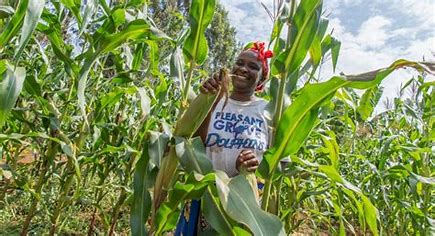
In late February, farmers from across the US will gather in Houston, Texas, to witness the crowning of their champions: the winners of the National Corn Yield Contest. Every year, thousands of participants brush up on the contest’s 17-page rule book and then attempt to plough, plant and fertilise their way into the record books.
Their aim? To squeeze as much corn as possible from each square metre of farmland.
The overall winner in 2023 – and in 2021, 2019 and nine times before that – was David Hula, a farmer from Charles City, Virginia. Hula is something like the Michael Phelps of competitive corn yields. He sets records, smashes them, then comes back for more. In 2023, his 623.84 bushels of corn per acre was more than three and a half times the national average.
A bunch of farmers competing to win a national garland might seem like a bit of rural frippery, but Hula’s record gets at something important. It shows just how much food can be grown if farmers use every tool at their disposal: high-yielding seed varieties, harmonious combinations of pesticides and herbicides, precision-applied fertiliser, the right amount of water exactly when it’s needed and so on. Get these factors right and farmers can dramatically boost how much food they produce on a given piece of land – potentially freeing up land elsewhere for forests or rewilding.
A new study into crop yields between 1975 and 2010 looked at where crop yields have lagged or raced ahead. The results give us some tantalising clues about where farmers and policy should focus in order to feed more people without turning lots more land into farms. Even more importantly, they suggest some big areas where sky-high yields might point to missed opportunities when it comes to feeding the world more sustainably.
The winners of the National Corn Yield Contest showcase the stonkingly high yields farmers can achieve, but most farmers globally don’t have access to the shiniest farm technology. As a consequence, their yields are lower, which brings us to a concept called the yield gap. Roughly speaking, this is the difference between the theoretical maximum amount of crops a farmer could grow per hectare in a given climate if everything went perfectly and the actual amount they grow.
To see the yield gap in action, compare two important corn producers: the US and Kenya. In the US, the average yield is around 10.8 tonnes per hectare, while in Kenya it’s 1.5 tonnes. While the US is very close to its maximum theoretical corn yields, Kenya – taking into account its different climate – is way below its theoretical maximum. In other words, the US barely has a corn yield gap at all, while Kenya has a yield gap of about 2.7 tonnes per hectare below its theoretical maximum.
Yield gaps are important because they tell us where farms could become much more productive, says James Gerber, a data scientist at the climate nonprofit Project Drawdown and lead author of the paper. Raising yields in sub-Saharan Africa is particularly critical because it is already one of the hungriest parts of the world, and the population there is projected to double by 2050.
Gerber and his colleagues looked at how yield gaps had changed in a given area between 1975 and 2010 for 10 major crops. The thing with yield gaps, Gerber says, is that no yield gap at all might be just as bad as a large one. The theoretical maximum yield tends to increase as scientists develop new varieties of crops and better farming techniques, which would keep a yield gap growing as farmers slowly adopt these new technologies.
Corn yields more than doubled in the US between 1960 and 2000 as researchers developed new high-yielding varieties and smarter ways to farm. The same is true for wheat in the Netherlands, says Martin van Ittersum at Wageningen University – new cultivars come along that push up the potential wheat yields, widening the yield gap.
If the maximum yield isn’t going up, that might be because there simply isn’t enough work going into developing better crop varieties and farming techniques. Worryingly, Gerber found that this seemed to be the case for rice. Maximum yields were growing in only 12 per cent of rice fields in Gerber’s analysis. In most places, yield growth for rice seemed to have stalled. That could be an ominous sign. Rice is a crucial crop for feeding people, providing a fifth of the calories for all humans each day, according to some estimates.
Gerber draws a contrast between the situation with rice and that of corn and soybean, which have increasing yield gaps, indicating growing maximum yields. A relatively small proportion of corn and soybean crops goes to humans directly as food.
In the US, 45 per cent of corn production is used for biofuels, and another 40 per cent goes to animal feed. Globally, more than three-quarters of soybean production goes to feeding livestock and since animals are relatively inefficient at turning calories into meat, only a slim share of those calories from soy ever make it into human diets.
For Gerber, this paints a grim picture. It means that the bits of agricultural production that are really storming ahead are precisely those parts that don’t feed many humans. This is bad news for the planet, because it means we’re not using our farmed land in the most efficient way possible, meaning less food for people and less land for rewilding.
Biofuel production is a particularly awkward situation because biofuel incentives in the US have prompted farmers to bring new land into cultivation, potentially releasing greenhouse gases that would otherwise stay locked up in the soil and so negating any of the benefits of growing crops for fuel.
Gerber’s analysis can’t say why corn and soybean yield gaps are steadily increasing while other crops lag behind, but he suspects it has a lot to do with where money for subsidies and research is directed. “Corn is getting all the investment. Corn and soya because those are commodity crops, and those are subsidised in the US,” he says.
Another, more obvious, result from yield gap research is the huge disparity between sub-Saharan Africa and much of the rest of the world. Agriculture in sub-Saharan Africa lags by almost every productivity metric, leaving hundreds of millions of people at risk of hunger and making it harder for them to leave poverty.
Growth in agricultural productivity is strongly linked with lifting people out of poverty, and that is particularly true in sub-Saharan Africa, where most people living in extreme poverty work in agriculture.
Yields are low in sub-Saharan Africa due to many factors, including a lack of infrastructure, under-developed markets, poor access to what markets there are, and political instability, says Van Ittersum. “To really change that requires huge investments. Once those are there and it’s created, I think it’s relatively easy to make progress,” he says. “There is plenty of scope to increase yields through better management and better agronomy in Africa and South Asia. Those are the areas where demand will also increase faster than anywhere else.”
Gerber says his research points to two ways in which we can produce more food on less land. The first is directing more investment towards crops like rice, and the second is encouraging people to change their diets so more calories grown go directly to feeding humans.
If we can make fields more productive in the right way, that should reduce the pressure to bring new land into cultivation.
“It’s often much more desirable to produce more on that existing agricultural land rather than expanding agricultural areas to forests or natural areas,” Van Ittersum says.
With half of the world’s habitable land already used for food production, decisions about the kinds of crops we grow, and how intensely, have a huge knock-on effect on biodiversity, habitat loss and forest cover. David Hula and the other winners at the National Corn Yield Contest might be onto something after all.
- A Nature report











